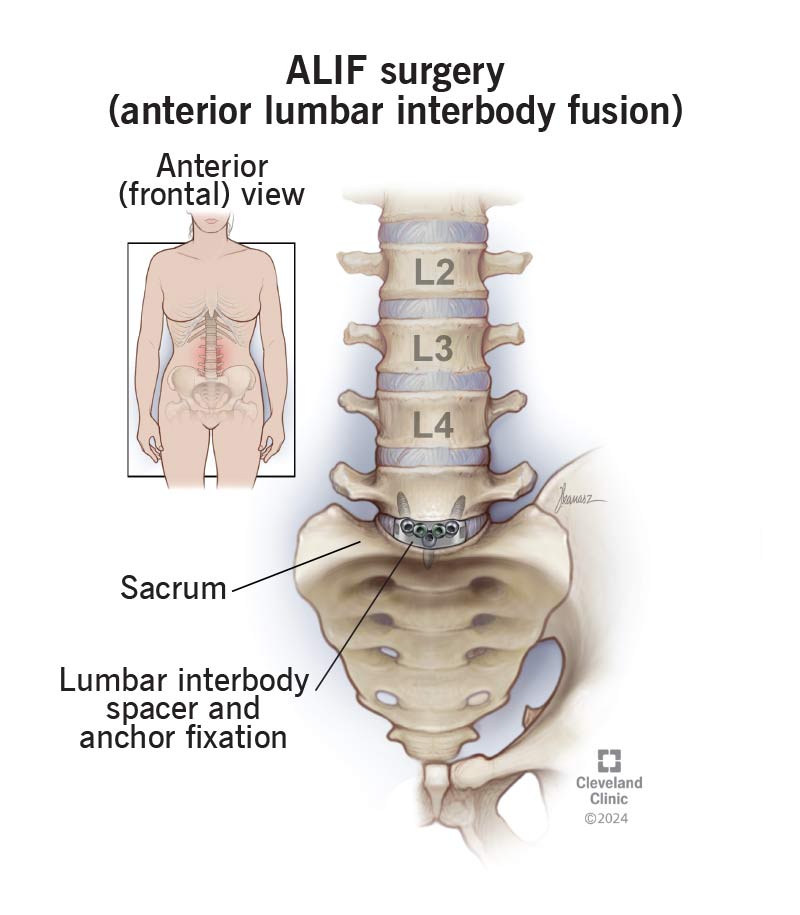ALIF (anterior lumbar interbody fusion) is a common surgical solution for degenerative disk disease and other conditions that affect the disks in your lower back that cushion your vertebrae. In ALIF, a surgical team makes incisions in your abdomen to get access to your vertebrae so they can replace damaged disks with bone grafts that eventually make your vertebrae fuse together.
Advertisement
Cleveland Clinic is a non-profit academic medical center. Advertising on our site helps support our mission. We do not endorse non-Cleveland Clinic products or services. Policy

ALIF (anterior lumbar interbody fusion) is surgery to treat degenerative disk disease and other conditions that happen when damaged or worn-out intervertebral disks put pressure on your spinal nerves. Intervertebral disks are the round cushions in your spine that separate and cushion your vertebrae. In ALIF, surgeons replace your damaged disks with bone grafts, reducing pressure on your spinal nerves. These grafts eventually create new bone that fuses or joins vertebrae together.
Advertisement
Cleveland Clinic is a non-profit academic medical center. Advertising on our site helps support our mission. We do not endorse non-Cleveland Clinic products or services. Policy
Anterior lumbar interbody fusion is a type of spinal fusion. It gets its name from the way healthcare providers perform the operation: Surgeons access your lower back (lumbar) from the front (anterior) of your body by making an incision in your abdomen (belly) so they can insert a bone or titanium graft between your vertebrae (interbody) that will fuse or join your vertebrae (fusion).
Surgeons use ALIF to treat conditions including:
Your surgeon may recommend ALIF if you’ve already had multiple spinal operations.
It’s a common surgical treatment for degenerative disk diseases and other conditions that cause severe lower back pain because damaged disks put pressure on spinal nerves. Typically, ALIF and other lumbar surgery happen when pain management, physical therapy or other treatments haven’t eased back issues.
While ALIF is minimally invasive spine surgery, it’s still major surgery. ALIF is done under general anesthesia and involves an access surgeon making an incision in your abdomen (belly) so a spine surgeon can access your lower back to remove the worn-out disk and replace it with a graft.
A lot goes on before your surgery:
Advertisement
The first step is confirming that ALIF is the right treatment to ease your back pain. Your surgical team will ask about your medical history, including any abdominal surgeries that may have left scar tissue in your abdomen. Your team may:
You should:
You should:
At the hospital, you’ll meet with your anesthesiologist. They’ll explain the type of anesthesia you’ll receive and what to expect as you recover from anesthesia.
A healthcare provider will take you to the operating room where you’ll lie face up on an operating table. You’ll receive anesthesia that will make you unconscious. Your team will clean the skin on your belly.
ALIF surgery involves an access surgeon and a spine surgeon. Your access surgeon will:
Next, your spine surgeon will:
Advertisement
Depending on your situation, your spine surgeon may want to do additional surgery to add more stabilizing devices. Your spine surgeon will explain why they recommend this and what you can expect.
A typical surgery takes about one to two hours. Your surgery could take more time if your surgical team needs to replace several damaged disks or if you’ve had previous abdominal surgery.
Your team will move you to a recovery area, where you’ll rest while you recover from anesthesia. Your recovery room team will regularly check your pulse, breathing and other vital signs, and give you medication for pain.
You’ll move to another room in the hospital to continue recovering from your surgery. Your surgical team will check for complications like infections. You may need to spend three or four days in the hospital. While you’re there, your team will help you take small steps toward recovery, like standing and walking on the first day after surgery.
There are several advantages:
Advertisement
Like most surgeries, ALIF complications may include risk of infection and excessive blood loss. Other potential complications include:
ALIF surgery recovery is a marathon, not a sprint. It can take several months before you can do things like lift heavy objects, bend at the waist or twist your upper body. If you had several damaged disks, you may never be able to lift heavy weights, do work that requires lifting heavy weights or take part in impact sports.
Bone growth is steady but slow. It could take a full year before your bone graft completely fills in the space and fuses with your vertebrae.
Three words: Take it easy. It may be several weeks before you’re able to do things like bend, twist, lift objects or drive without pain.
Research shows ALIF successfully treats symptoms from conditions that damage vertebral disks. One study showed successful bone fusion in 99% of ALIF surgeries.
You should contact your provider if:
Advertisement
If you’re thinking of having ALIF (anterior lumbar interbody fusion) surgery, it’s likely you’ve been coping with lower back issues that hurt and make it hard for you to get around. It’s also likely you’ve had other treatments like physical therapy or medication, but you’re still hurting. ALIF surgery is a common and effective treatment for lower back pain. But it’s still back surgery, which may make you feel anxious about the procedure. Your healthcare team understands this is a big decision. Take your time to make your decision, and never hesitate to ask questions.
Last reviewed on 01/02/2024.
Learn more about the Health Library and our editorial process.